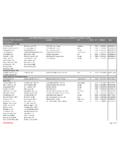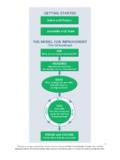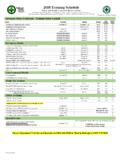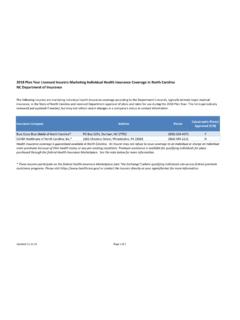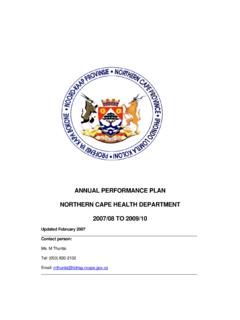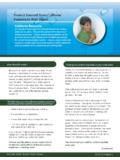Transcription of Basic Food Regs - Harrison County
1 Page 1 of 4 Basic Health Department food Service Regulations This is NOT the entire food rule (410 IAC 7-24) The entire food rule can be found online at C Critical violation NC Non-critical violation Employees Sections 106 138 128 C Must wash hands as required per Sec. 129 of the food Code 133a NC Nails trimmed, filed 133b NC No nail polish or artificial nails unless wearing gloves 133c C Cuts, lesions on hands/arms covered with impermeable covering 134 NC No jewelry except for simple wedding band. No watches, bracelets 135 NC Clean clothing 136a C No eating, drinking, chewing gum, using tobacco except in designated areas 136b C Employee s cups must have lid and straw 137 C Employees experiencing persistent sneezing, coughing, runny nose or other discharges from eyes, nose or mouth may not work with exposed food , clean equipment or utensils, or unwrapped single-service articles (napkins, plastic forks, etc.)
2 138 NC Hair properly restrained pulled back plus hairnet, hat, or scarf food Sections 139 204 142 C Must be from an approved source (ex. USDA, FDA inspected). May not use raw milk or farm eggs 140 NC food must be honestly presented (ex. cannot serve Pollock and call it cod) 142 C food may not be prepared in a private home 144 C Packaging must be in good condition and protect contents from contamination (may NOT use Wal-Mart bags as food contact bags NOT food -safe) 154 155 C Fish and shellfish must be commercially harvested 162 C Sushi/sashimi shall be frozen throughout to -4 F for 7 days or -31 F for 15 hours before serving to kill parasites 164 C Mushrooms cannot be picked in the wild and sold 165 C Hunter harvested meat cannot be sold 166 C Refrigerated food must be received <41 F 170 NC Ice used as an exterior coolant cannot be used as food (cannot place drinks, container of lemons, etc.)
3 In ice bin) 171 C May NOT touch ready-to-eat food with bare hands. Must use deli tissue, tongs, gloves, etc. 172 C May not re-use utensil used for tasting without washing it 173 C Foods must be protected from cross-contamination 174 NC food removed from its original container must be labeled unless it is unmistakably recognizable 175 NC Raw fruits/vegetables must be washed before they are cut 177 NC food must be stored at least 6 above the floor unless the container is impermeable C or NC, depending on type of possible contamination 178 NC food may not be stored in restrooms, mechanical rooms, garbage rooms, etc. or under dripping lines 181 C/ NC Buffets/salad bars must be monitored by an employees trained in safe operating procedures 182 C food shall be cooked to proper internal temperatures see Sec. 182 of the food Code 183 C Raw animal food that is microwaved shall be properly cooked per Sec.
4 183 187 C Hot holding temperature is at least 135 F 187 C Cold holding temperature is 41 F, maximum 188 C Potentially hazardous food that is cooked, cooled and reheated must be reheated so all parts of the food reach at least 165 F 189 C Cooked potentially hazardous food must be cooled from 135 F to 70 F within 2 hours, then from 70 F to 41 F within 4 additional hours 191 C Ready-to-eat potentially hazardous refrigerated food shall be properly date marked per Sec. 191 192 C food that is not properly date-marked must be discarded 193 C Time may be used as a public health control only as specified under Sec. 193 196 C A consumer advisory must appear on the menu, etc. if food of animal origin is served raw or undercooked 199 NC Frozen food may be thawed only as specified under Sec. 199 200 C food may only contact surfaces that are clean and sanitized 201 C Returned food may not be offered for re-sale Page 2 of 4 203 NC Unpackaged food shall be protected from environmental sources of contamination ( cooking outside) 204 NC food shall be protected from misc.
5 Sources of contamination not herein specified Equipment, Utensils, Linens, Single-Use & Single-Service Items Sections 205 319 205 C food contact surfaces of utensils must be safe, durable, non-absorbent, smooth, easily cleanable, resistant to pitting, chipping, etc. 208 209 C Galvanized metal, copper may not be used for utensils, pots, used with acidic foods 210 NC Sponges may not be used in contact with food contact surfaces 213 NC Wood may not be used as a food contact surface except in cutting boards, rolling pins, salad bowls, chopsticks, wooden paddles used in confectionary operations 214 NC Cutting surfaces (cutting boards) must be discarded if they cannot be properly cleaned or resurfaced 216 NC Non- food contact surfaces exposed to splash, spill, or soiling that needs frequent cleaning must be smooth, easily cleanable, non-absorbent, corrosion resistant 217 NC Equipment & utensils must be durable under normal use 218 NC Equipment must be kept in a state of good repair.
6 Door seals, hinges, fasteners, kick plates must be kept intact, tight & adjusted properly 224 NC Beverage tubing may not be installed in contact with ice for human consumption 229 C food -contact surfaces must be smooth, free of cracks, chips, pits, seams, free of sharp internal corners, etc. 233 NC A food dispensing utensil shall be available for each item at a buffet, salad bar, etc. 234 NC food dispensing utensils may only be stored in one of the following ways: -- in the food with the handle above the top of the food -- on a clean area if the utensil and the area have been cleaned and sanitized -- in running water (as an ice cream dipper well) -- in a clean protected area (as for an ice scoop) if only used with food that is not potentially hazardous -- in clean water of at least 135 F 235 NC Utensils must be maintained is a good state of repair (ex: beaters/whips cannot have broken wires/blades) 236 NC Linens may not be used except to line a container (ex.)
7 A bread basket) and must be replaced each time container is refilled for a new customer 239 NC Clean equipment, linens, utensils must be stored with handles inverted, at least 6 above floor, in clean, dry areas where they will not be contaminated 241 C Single-use articles (napkins, cups, plastic utensils, etc) must be used if no dishwashing/sanitizing facilities are available 242 NC Single-use items may not be re-used 243 NC Single-use items must be stored at least 6 above the floor in a clean, dry location away from drips, splash, contamination, etc. 244 NC Utensils, linens, single-use items may not be stored in restrooms, garbage rooms, mechanical rooms, etc. 245 NC Wiping cloths used for food spills shall be used for no other purpose. Wet wiping cloths must be stored in sanitizer 246 C/ NC Gloves shall be used for one task, discarded when damaged or soiled or interruptions occur in the operation (ex: must quit prepping food and go to cash register) 249 NC Consumers cannot refill their own dirty plates (ex.
8 At a buffet) 250 NC Silverware not pre-wrapped must be presented handle up. Can t touch lip-contact surfaces of cups with bare hands 251 NC Soiled tableware must be removed from consumer eating/drinking areas so clean tableware is not contaminated 252 NC Preset tableware must be wrapped, covered, or inverted 253 C food thermometers may not be glass unless encased in a shatterproof coating 254 NC Thermometers must be accurate to within 2 F +/- 257 NC Thermometers for measuring the temperature of food shall be provided and readily accessible 259 NC Must have enough equipment for heating and cooling food 269 C Must have a 3-compartment sink and/or a proper warewashing machine that complies with code 271 to 287 C/ NC See Sections 271 287 for dishwashing info regarding water temps, sanitizing methods, etc. 288 289 NC Drain boards must be self-draining (no towels on them) and large enough 291 NC Must have sanitizer test strips 293 NC Dishwashing sink must not be used for hand washing or as a mop sink Page 3 of 4 294 C Dishwasher temp, pH, sanitizer strength 295a 295b C Equipment food -contact surfaces and utensils must be clean to the sight and touch.
9 Pans must be kept free of encrusted grease and other accumulations 295c NC Nonfood-contact surfaces of equipment must be kept free of dust, dirt, food residue, etc. 296 to 303 C NC Other washing, rinsing, sanitizing info see Secs. 296 303 304 NC Air drying of dishes is required no towel drying 305 NC Vent hood/filters must be removable for cleaning 306 NC Vent hoods may not drip grease or condensation onto food , equipment, utensils, etc. 307 NC Vent hoods must meet all fire and building codes and be adequate to prevent grease or condensation from collecting on walls and ceilings 308 NC Vents cannot cause contamination of food or equipment 309 NC Vents must be adequate to remove excessive heat, steam, condensation, obnoxious odors, smoke, fumes, etc. 310 NC Intake and exhaust ducts shall be cleaned and filters changed so they are not a source of contamination.
10 If vented to outside they cannot create a nuisance, hazard or unlawful discharge. Water, Plumbing, Water Fixtures and Waste Sections 320 398 320 C Drinking water must come from an approved source 321 C The water system shall be flushed and disinfected after construction, repair, or modification or after an emergency such as a flood 322 C The plumbing system must meet all plumbing codes and meet the capacity needs of the food establishment 324 C The plumbing system shall be repaired according to the law and be maintained in good repair 325 C Bottled drinking water must come from an approved source 326 C Non-drinking water can only be used for non-culinary purposes 327 NC If use a well, water must be tested by an approved lab at least 1x per year 329 C Water source and hot water capacity must be sufficient to meet the needs of the food establishment 330 NC Water pressure must be adequate 334 C An air gap between the faucet (etc.)
